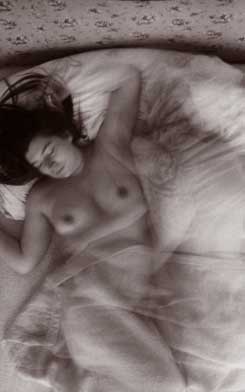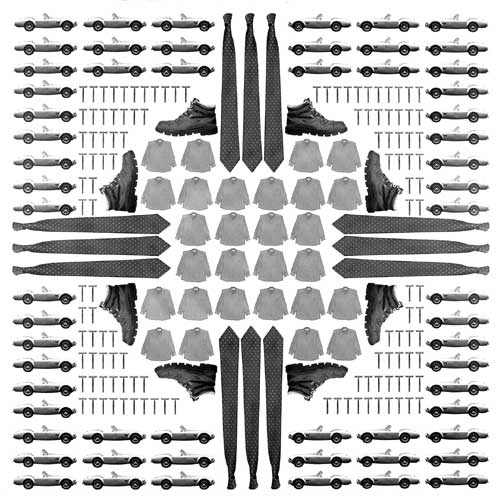
Mandale / Mandalas, 1997, 100/100 cm
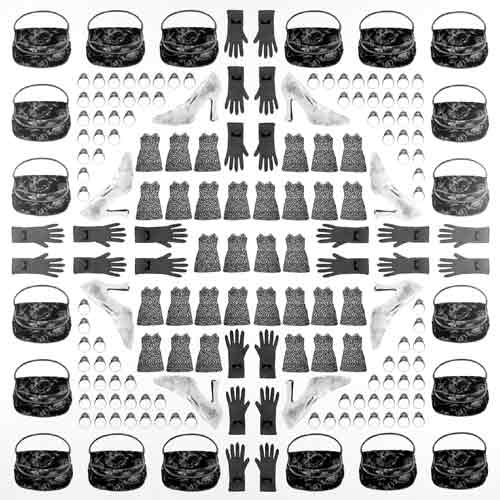
W poszukiwaniu mitologii czyli niekonwencje fotograficzne Dariusza Liszewskiego
Hasło - postmodernizm: jakże pięknie pasuje to określenie do fotografii, hybrydy wizualnej współczesności.
Gdyby spróbować nadużyć pytania: która z technik plastycznych jest najbardziej postmodernistyczna, nie wahałbym się potwierdzić : no tak, fotografia.
Wielowymiarowy, techniczny, obyczajowy i artystyczny "żywioł". Wszystko i nic.
I pytanie które ciągle niepokoi: ile obrazów fotograficznych oglądamy codziennie?
A ile z nich ma istotną wartość ? A ile potrafimy rozkodować i zrozumieć, jeżeli tylko jest co rozkodować i zrozumieć.
Codzienne doświadczenie człowieka miasta: coraz bardziej dynamicznie zmieniający się przepływ obrazów/informacji, powodujący narastającą w pozorach wartość objaśniania i poznawania (jakkolwiek rozumianej) rzeczywistości.
Wielość i szybkość obrazów/informacji prowadząca do rozproszenia. Coraz mniejsze szanse na konieczne do zrozumienia i poznania - skupienie i uwagę.
Na naszych oczach (sic!) w coraz większym informacyjnym chaosie, wydaje się, że coraz bardziej przypominającym mentalnie las naszych przodków, w tym obszarze wymagającym skupienia, wiedzy, uwagi i szybkiej orientacji, jeżeli tylko chcemy się w nim odnaleźć i wyłowić coś wartego naszego większego zainteresowania, zatraca się podstawowa funkcja czytelności obrazów.
Można by rzec, że obrazy płyną, a mity przez nie stwarzane trwają chwilę, dzień, tydzień, miesiąc...
Człowiek miasta, Dariusz Liszewski - postmodernistyczny: jak miasto w którym mieszka, zanurzony w chaosie przepływających obrazów, zakochany "niemodnie" w malarstwie secesyjnym, nadrealizmie Salvadora Dali. Czerpiący inspirację do swoich kolejnych martwych natur - z wydaje się - opatrzonego już Van Gogha. Ujawniający za pomocą fotografii "... swój intymny mały świat" i odnajdujący w nim motywy mitologiczne.
Jego twórczość jest jak wielobarwny Kilim utkany z fotograficznych negatywów i kolorowych materiałów odpadowych. Dziesiątki, setki małych obrazków "unieważnionych" poprzez wplecenie w materię, zamienionych w ozdobność, ale i posiadających swoją siłę poprzez manifestację, że fotografia jest nieważna. Tak nieważna jak każda technika.
Ważne jest do czego służy i co można ujawnić za jej pomocą. Kolejne, żmudne wplatanie w Kilim "motywów" jak wymagająca cierpliwości i samozaparcia, ulubiona
i kultywowana od paru lat przez Dariusza Liszewskiego, technika fotografii otworkowej.
Widoczne inspiracje malarskie w fotograficznej twórczości Dariusza Liszewskiego są grą. I jak każda gra wymagają reguł.
W przypadku serii kolorowych aktów wykonanych techniką fotografii otworkowej te reguły to odniesienia do klimatu secesji i ukryty w tle cień mitologii.
Cała seria kobiecych aktów, jakby zatruta poprzez przesycone biele ciała, kontrast purpurowej czerwieni, zimny błękit i fiolet. Zestawienie kobiecych bioder z peoniami, zaplątanie w materię, anonimowość, poruszają wątek nieobecny w powszechnych i wszechobecnych kobiecych aktach... delikatny cień śmierci, motyw Thanatosa i Erosa, o których związku zdaje się, że współcześnie zapominamy.
Inna mityczna para ujawnia swą obecność w serii prac,
w których każda pojedyncza fotografia jest całonocną rejestracją snu kochanków.
To Morfeusz i Eros. Przemijalność, migotliwość i zespolenie. A drobnomieszczański wystrój wnętrza wzmacnia tylko nieprzemijalne doznanie powtarzalności instynktów
i rytuałów.
Powrót. Powrót, to charakterystyczny rys dla twórczości Dariusza Liszewskiego.
Poszukiwanie i odnajdywanie reguł gry rządzących tworzeniem mitologii i czytelności obrazów. Można by rzec - mitologii obrazów.
Postmodernistyczna wolność wykorzystywana w celu odnalezienia porządku w otaczającym chaosie, w którego poszukiwaniu nie są tylko kolejnym zestawem przemykających obrazów.
Krzysztof J. Baranowski
Poznań, 6 sierpnia 2003
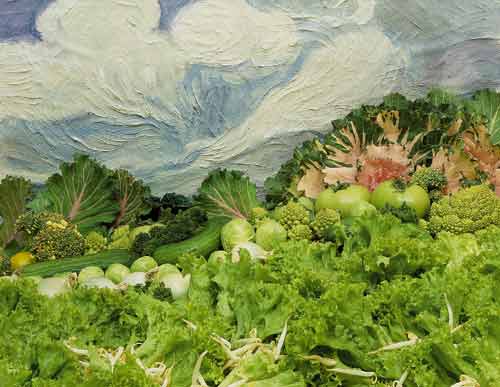
Les environs de Arles, 1999, 40/50 cm
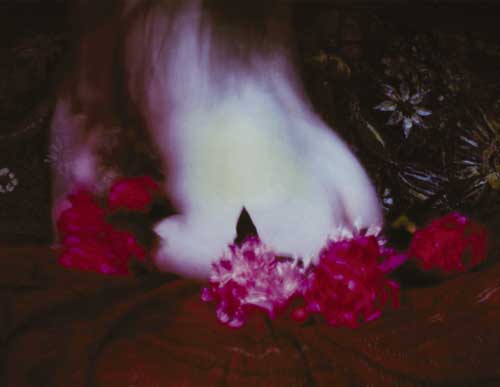
Linea sensibila, 2002, 40/50 cm
In the search of mythology or photographic inconsistencies of Ddariusz Liszewski
The slogan of postmodernism: how well it fits photography, a visual hybrid of contemporaneity.
If we were to abuse the question which plastic technique is most postmodernistic I would not hesitate to answer: of course, photography.
A multidimensional, technical, social and artistic "element". Everything and nothing.
And a question which is laways disturbing: how many photographic images a day do we see?
And how many of them have significant value? How many are we able to decode and understand if there is anything to decode and understand.
The everyday experience of a city dweller: an ever more and more changing flow of images/information which causes the growth of illusions of the value of explaining and knowing reality, however this term may be understood.
A great number and speed of images/information which causes deconcentration. The gradually smaller chances to attain concentration and attention necessary for understanding and knowledge.
Before our very eyes (sic!), in the growing information chaos which seems to resemble mentally the forests of our ancestors, in this sphere which demands concentration, knowledge, attention and quick reactions if we only want to find our way in it and catch something that is worth our interest the basic function of the legibility of images is lost.
One could say that images flow while the myths they create last for a moment, a day, a week, a month...
A city dweller, Dariusz Liszewski a postmodernist: as the city he lives in, immersed in the chaos of flowing pictures, in love with oldfashioned art nouveau painting or Salvadore Dali's surrealism. Inspired in his still-lives by the seemingly all too well known Van Gogh. Revealing by means of photography "... his own intimate world" and finding in it mythological motifs.
His works are like the colourful Kilim (Tapestry), woven from photographic negatives and colour waste material. Tens and hundreds of little pictures "invalidated" by interweaving into matter, transformed into ornamentation but possessing its power since it manifests that photography is unimportant. As unimportant as every other technique.
What is important is what it is used for and what can be revealed using it. Another painstaking act of interweaving certain "motifs" into his Kilim, like Dariusz Liszewski's favourite and cultivated for a few years now technique
of pinhole photography.
Painting inspirations visible in the photographic works of Dariusz Liszewski are a game. And like every game they demand certain rules.
In the case of a series of colour nudes photographed using the pinhole technique those rules are references to the atmosphere of art nouveau and the shade of mythology hidden in the background.
The whole series of female nudes, as if poisoned by the whiteness permeating their bodies, the contrast of purple redness, cold blue and violet. The combination of female hips and peonies, entanglement in matter and anonymity touch a subplot absent in universal and ubiquitous female nudes... A delicate shade of death, motif of Thanatos and Eros about whose relation we seem to forget in modern times.
Another mythical pair reveals their presence in a series of works in which every single photograph is a registration of a whole night's sleep of two lovers.
It is Morpheus and Eros. Transitoriness, twinkling and unification. And the petty bourgeois interior decoration only strengthens the permanent feeling of the repetition of instincts and rituals.
Return. A return is a characteristic motif in Dariusz Liszewski's work.
The search for and the finding of the rules of the game which govern the proces of creating mythology and legibility of images. One could say the mythology of images.
Postmodernist freedom used in order to find order in the surrounding chaos, in a search that will not be only the next set of fleeting images.
The slogan of postmodernism: how well it fits photography, a visual hybrid of contemporaneity.
If we were to abuse the question which plastic technique is most postmodernistic I would not hesitate to answer: of course, photography.
A multidimensional, technical, social and artistic "element". Everything and nothing.
And a question which is laways disturbing: how many photographic images a day do we see?
And how many of them have significant value? How many are we able to decode and understand if there is anything to decode and understand.
The everyday experience of a city dweller: an ever more and more changing flow of images/information which causes the growth of illusions of the value of explaining and knowing reality, however this term may be understood.
A great number and speed of images/information which causes deconcentration. The gradually smaller chances to attain concentration and attention necessary for understanding and knowledge.
Before our very eyes (sic!), in the growing information chaos which seems to resemble mentally the forests of our ancestors, in this sphere which demands concentration, knowledge, attention and quick reactions if we only want to find our way in it and catch something that is worth our interest the basic function of the legibility of images is lost.
One could say that images flow while the myths they create last for a moment, a day, a week, a month...
A city dweller, Dariusz Liszewski a postmodernist: as the city he lives in, immersed in the chaos of flowing pictures, in love with oldfashioned art nouveau painting or Salvadore Dali's surrealism. Inspired in his still-lives by the seemingly all too well known Van Gogh. Revealing by means of photography "... his own intimate world" and finding in it mythological motifs.
His works are like the colourful Kilim (Tapestry), woven from photographic negatives and colour waste material. Tens and hundreds of little pictures "invalidated" by interweaving into matter, transformed into ornamentation but possessing its power since it manifests that photography is unimportant. As unimportant as every other technique.
What is important is what it is used for and what can be revealed using it. Another painstaking act of interweaving certain "motifs" into his Kilim, like Dariusz Liszewski's favourite and cultivated for a few years now technique
of pinhole photography.
Painting inspirations visible in the photographic works of Dariusz Liszewski are a game. And like every game they demand certain rules.
In the case of a series of colour nudes photographed using the pinhole technique those rules are references to the atmosphere of art nouveau and the shade of mythology hidden in the background.
The whole series of female nudes, as if poisoned by the whiteness permeating their bodies, the contrast of purple redness, cold blue and violet. The combination of female hips and peonies, entanglement in matter and anonymity touch a subplot absent in universal and ubiquitous female nudes... A delicate shade of death, motif of Thanatos and Eros about whose relation we seem to forget in modern times.
Another mythical pair reveals their presence in a series of works in which every single photograph is a registration of a whole night's sleep of two lovers.
It is Morpheus and Eros. Transitoriness, twinkling and unification. And the petty bourgeois interior decoration only strengthens the permanent feeling of the repetition of instincts and rituals.
Return. A return is a characteristic motif in Dariusz Liszewski's work.
The search for and the finding of the rules of the game which govern the proces of creating mythology and legibility of images. One could say the mythology of images.
Postmodernist freedom used in order to find order in the surrounding chaos, in a search that will not be only the next set of fleeting images.
Krzysztof J. Baranowski
Poznań, August 6th 2003
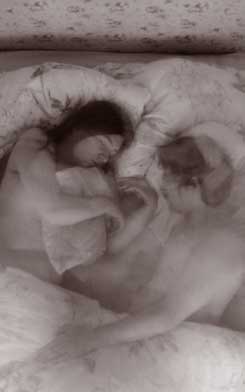
Sen / the Dream, 2001, 13/18 cm
Copyright ©2003 Galeria FF ŁDK, Dariusz Liszewski, Krzysztof J. Baranowski.






